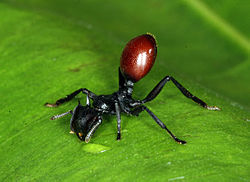- Myrmeconema neotropicum
-
Myrmeconema neotropicum 
Cephalotes atratus ant infected with Myrmeconema neotropicum showing swollen red abdomen Scientific classification Kingdom: Animalia Phylum: Nematoda Class: Adenophorea Subclass: Enoplia Order: Mermithida Family: Tetradonematidae Genus: Myrmeconema Species: M. neotropicum Binomial name Myrmeconema neotropicum
Poinar & Yanoviak, 2008Myrmeconema neotropicum is a tetradonematid nematode parasite.
At present, the only known host species is Cephalotes atratus, a South American ant with a black abdomen. Upon infection, the gaster, or bulbous hindmost region of the abdomen, resembles one of the many red berries found in tropical forest canopies.
Myrmeconema neotropicum is a new genus and species of parasitic tetradonematid nematode that apparently induces fruit mimicry in the tropical ant Cephalotes atratus. Infected ants develop bright red gasters, tend to be more sluggish, and walk with their gasters in a conspicuous elevated position. These changes likely cause frugivorous birds to confuse the infected ants for berries and eat them. Parasite eggs passed in the bird's feces are subsequently collected by foraging Cephalotes atratus and are fed to their larvae, thus completing the life cycle of Myrmeconema neotropicum (Yanoviak et al. 2008).
Female Myrmeconema neotropicum mature within the gaster of the host ants. They are about 1000 μm in length and about 112 μm at their greatest width. Males are smaller than females (680 μm in length and 97 μm in diameter) (Poinar & Yanoviak 2008). The adult worms mate within the gaster of the ant pupa. The male worm dies and eggs develop within the female as the ant becomes an adult. The infected young adult ant is completely black and spends most of its time tending brood within the nest. As the parasite embryos develop within the eggs, the ant gaster becomes translucent, ultimately appearing as bright red. Increased reddening coincides with a shift in ant behavior that includes foraging outside the nest, thus increasing the probability of consumption by a duped bird. Although bird predation on an infected Cephalotes atratus has not yet been observed, the combination of field experiments and the known natural history of the ant indicate that this is the most parsimonious explanation for transmission of the parasite to new ant colonies.
References
- Poinar, George; Stephen P. Yanoviak (February 2008). "Myrmeconema neotropicum n g, n sp, a new tetradonematid nematode parasitising South American populations of Cephalotes atratus (Hymenoptera: Formicidae), with the discovery of an apparent parasite–induced host morph". Systematic Parasitology 29 (2): 145–153. doi:10.1007/s11230-007-9125-3. PMID 18038201.
- Sanders, Robert (2008-01-16). "Ant parasite turns host into ripe red berry, biologists discover". UC Berkeley NewsCenter. http://www.berkeley.edu/news/media/releases/2008/01/16_ants.shtml.
- Yanoviak, S. P., M. Kaspari, R. Dudley, G. Poinar Jr. 2008. Parasite-induced fruit mimicry in a tropical canopy ant. The American Naturalist 171:4, 536–544.
Categories:- Nematode stubs
- Parasite stubs
- Myrmeconema
- Nematodes
- Parasites
Wikimedia Foundation. 2010.
